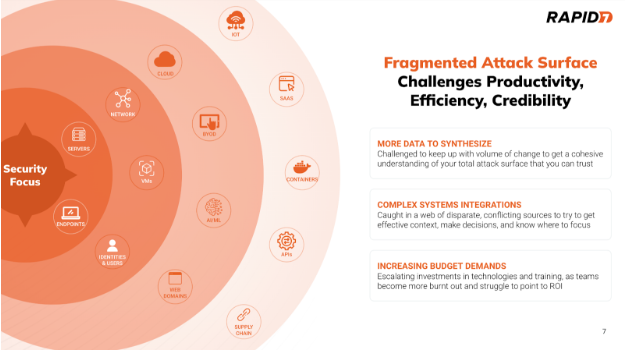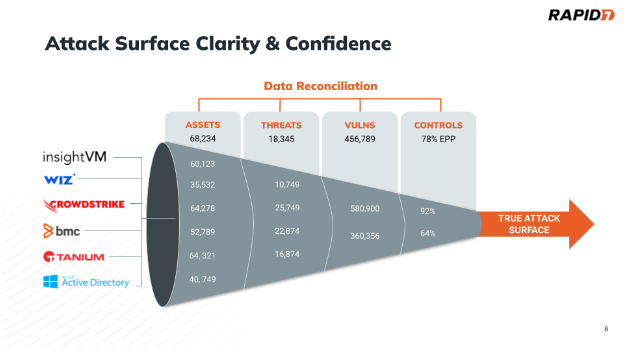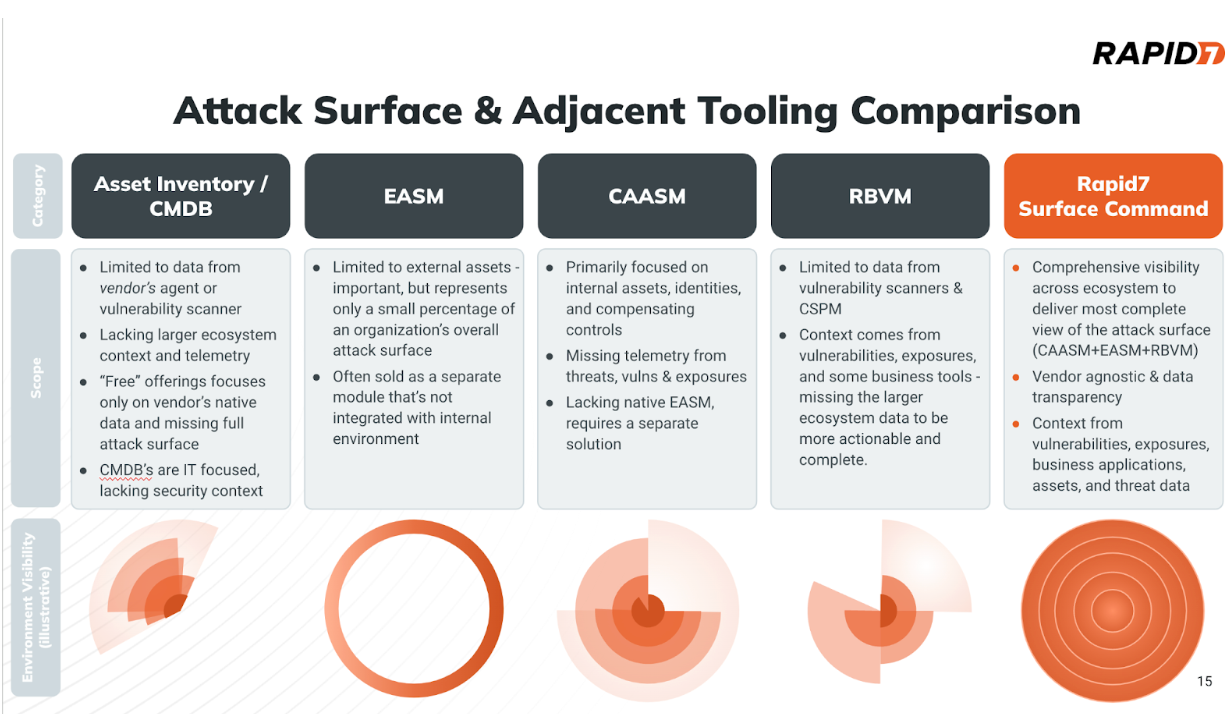Rapid 7 - Help, I can’t see! A Primer for Attack Surface Management blog series
Part 1: Overview of the Problem ASM Solves and a High-Level Description of ASM and Its Components

Welcome to the first installment of our multipart series, "Help! I Can’t See! A Primer for Attack Surface Management Blog Series." In this series, we will explore the critical challenges and solutions associated with Attack Surface Management (ASM), a vital aspect of modern cybersecurity strategy. This initial blog, titled "Overview of the Problem ASM Solves and a High-Level Description of ASM and Its Components," sets the stage by examining the growing difficulties organizations face in managing their digital environments and how ASM can help address these issues effectively.
The fast paced evolution of digital infrastructure that is driving businesses forward (e.g. workstations, virtual machines, containers, edge) is also making it more difficult for organizations to keep track of and account for the cyber attack surface they’re responsible for protecting. Despite security teams continuing to invest exorbitant amounts of money on tools (VM, EDR, CNAPP, etc.) to both manage their digital environment and also secure it, the problem isn’t getting any better. In this 3-part blog series we will help demystify the problems of security data silos and tool sprawl so you can answer pertinent questions like
- How many assets and identities am I responsible for protecting?
- How many assets and identities are lacking security controls like endpoint security or MFA?
- What is my overall security posture?
When we look at the number and types of tools organizations spend money on to manage and secure their digital environment, we typically see things like vulnerability scanners, endpoint security, IdP, patching, IT asset management, Cloud Service Providers, and more. Each of these tools and technologies tend to do a pretty good job at their core function but unintentionally contribute to a fractured ecosystem that provides organizations with contradictory information about their digital environment.

The age old problem: How many assets do I have?
Let’s look at a real-world example of this where an organization has solutions for Vulnerability Management (VM), Cloud Security Posture Management (CSPM), Endpoint Security (EDR/EPP), Active Directory (Directory Services) and IT Asset Management( ITAM).

None of these tools can agree on the number of assets in the environment. It’s practically impossible to achieve 100% deployment of agent-based tools across your business (some types of assets cannot have agents!). It then becomes a real challenge to see across these tooling visibility gaps. The result is that we cannot answer the basic question of “How many assets am I responsible for protecting”.
This fact is compounded because if we can’t agree on the total number of assets, then we don’t know the number of controls in place, the number of vulnerabilities and exposures that exist, and the number of active threats in our environment. Teams that manage and secure organizations are relying upon incorrect information in an environment where prioritization and decision making needs to be based on high-fidelity information that incorporates IT, security, and business context to lead to the best outcomes.
To drill down on these points, let’s pick on a few tools from the infographic for illustrative purposes. Wiz will only see assets in the cloud, Active Directory only sees assets (mostly Windows) tied to the Domain Controller, and traditional vulnerability scanners see across hybrid environments but tend to be mostly deployed on-premise. If you hone in on the numbers in the Asset column you will immediately notice that none of these tools agree on the number of assets in the environment. Lacking visibility and confidence in your attack surface is a big data problem, and deploying the latest shiny security tool is not going to fix it.
Ultimately, we have an industry created data problem that Rapid7 is not immune to. For a number of perfectly good reasons, we have created a fractured technology ecosystem that is preventing security teams from having the best data available to determine their cyber risk and enabling them to prioritize the most effective remediation and response.
We need to see across the gaps that truly matter; for that we need Attack Surface Management.
What is Attack Surface Management?
Attack Surface Management (ASM) is generally part of a wider Exposure Management program and is a different way to think about cyber risk by focusing on addressing the digital parts of the business that are most vulnerable to attack. Taking an attack surface-based approach to your security program needs to consider a number of different elements including:
- Discovery and inventory of all cyber assets in the organization, from the endpoint to the cloud
- Internet-scanning to identify unknown exposures and map them to the existing asset inventory
- High-fidelity visibility and insights into the IT, security, and business context of those assets
- Relationship-mapping between the assets and the wider network and business infrastructure
ASM is a continuous process that is constantly assessing the state of the attack surface by uncovering new or updated assets, identifying the use of shadow IT in network or cloud use cases and prioritizing exposures based on their potential risk to the business. These elements of discovery and prioritization are foundational elements of a Continuous Threat Exposure Management (CTEM) initiative, where security teams are taking a more holistic approach to managing all types of exposures in their organizations.
A positive trend that we are currently seeing is that security teams are going back to basics and focusing on cyber asset management to first discover and understand the assets they’re responsible for protecting, along with their business function.
They gain visibility into the assets through a combination of external scanning to identify internet-facing assets which are potentially higher risk, this is known as External Attack Surface Management (EASM). A complementary approach to cyber asset discovery that provides greater insights into the whole cyber estate uses API-based integrations into existing IT management and security tools to ingest asset data; this is known as Cyber Asset Attack Surface Management (CAASM). Together, they provide organizations with the asset visibility they need to drive security decisions.
Put simply, you cannot secure what you can’t see. Managing the attack surface requires asset discovery and visibility, combined with rich context from all tools in the environment.
Attack Surface Management vs. Asset Inventory
There is a common confusion with customers today that they already have elements of an ASM strategy with their current approach to asset inventory. This is typically based on an asset inventory system that IT is using for asset lifecycle management. A traditional asset inventory’s view of the environment is almost entirely based on what it is able to discover on its own, and with an IT focus. These are often agent-based, with limited integrations, so they are not able to take advantage of an organization’s wide range of tools, which impairs their value.
Many asset inventories today can only discover assets where they have a deployed agent, such as an endpoint agent or being tied to the domain controller. While these technologies are effective at making policy and configuration changes on their fleet of endpoints, they do not have a data aggregation and correlation engine that sees beyond the specific agent. Additionally, they have limited security insights and context, and are only able to provide a partial view of the attack surface, assuming that no agent has 100% coverage.
This is not the reality in most organizations, and it’s why one should not confuse Asset Inventories with Attack Surface Management, the latter being a much more effective approach to surfacing the best asset and security telemetry across your ecosystem. An Attack Surface Management solution will ingest data from an IT Asset Inventory or Management tool as one of many data sources to collate.
The next blog in this series will look at the different components of an ASM program, and how they can be leveraged to improve security hygiene and reduce cyber risk.

from Rapid7 Cybersecurity Blog https://blog.rapid7.com/2024/09/19/help-i-cant-see-a-primer-for-attack-surface-management-blog-series/
Comments
Post a Comment